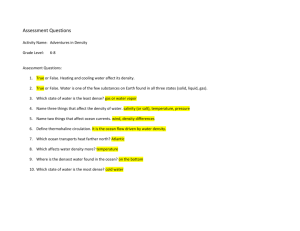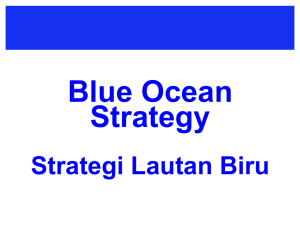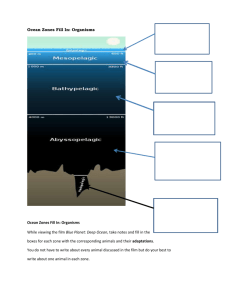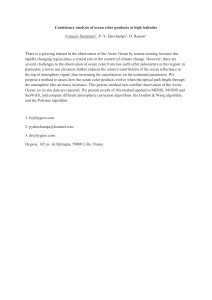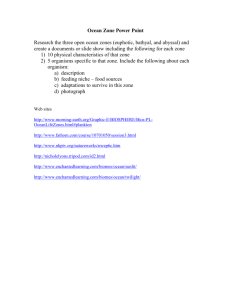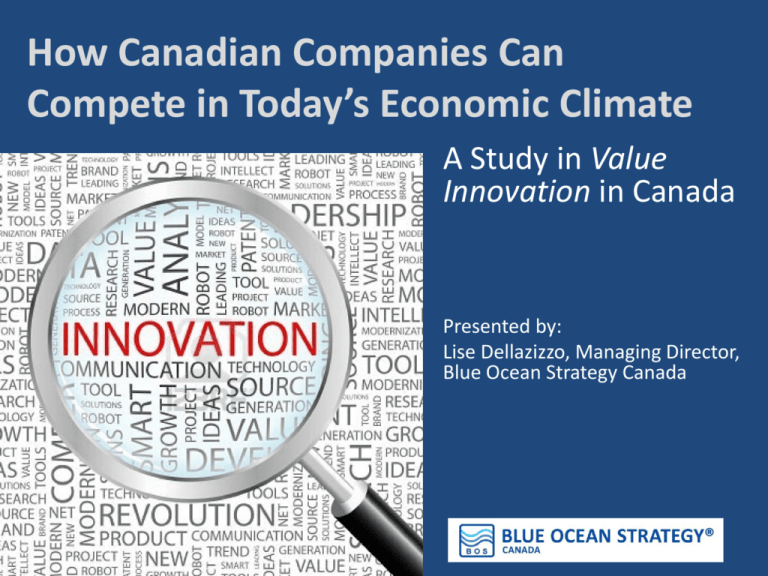
How Canadian Companies Can
Compete in Today’s Economic Climate
A Study in Value
Innovation in Canada
Presented by:
Lise Dellazizzo, Managing Director,
Blue Ocean Strategy Canada
A Look at the World Economic Picture
•
•
•
•
Overview
Europe
Asia
Commonwealth of
Independent States
• Africa and Middle East
• U.S.
Kim and Mauborgne © Blue Ocean
®
Strategy. UCSI Blue Ocean Strategy
Canada. All rights reserved.
Real Estate Trends
• Losing momentum in
developed world
• Subpar economic
growth result in
restraint
• Cautious lending
environment
Kim and Mauborgne © Blue Ocean
Strategy. ®UCSI Blue Ocean Strategy
Canada. All rights reserved.
Retail Trends
• South American retail
opportunities
• Rising deposable incomes in
China and India
• Promising growth in the
Middle East and North
Africa
• Consumer spending grew
1% in U.S.
• Modest increase in Canada
• Uncertainties slowed auto
and durable goods growth
Kim and Mauborgne © Blue Ocean
Strategy. ®UCSI Blue Ocean Strategy
Canada. All rights reserved.
Energy
• Analysts projecting crude oil to
average $106.80 a barrel in
2012, down from original
forecast, a result of the
deterioration in world GDP
• Fastest growth source of
primary energy will be
renewable energy, however
fossil fuels will continue to be
dominate energy source
• Worldwide energy
consumption will grow 53%
between 2008-2035; half of
which will come from India
and China
Kim and Mauborgne © Blue Ocean
Strategy. ®UCSI Blue Ocean Strategy
Canada. All rights reserved.
The Canadian Economy
• Canada’s output surpassed prerecession levels in 2010,
rebounding from ‘07-10 global
financial crisis
• Inflation averaged 1.8% in 2010
• Solid growth in Q1, 2011;
contracted slightly in Q2
• Healthy job growth, however
consumer spending remained
modest due to higher debts and
rising gasoline prices
• Business spending remained
strong; high commodity prices
continue to generate investment
in the resources sector
Kim and Mauborgne © Blue Ocean
Strategy. ®UCSI Blue Ocean Strategy
Canada. All rights reserved.
Canada’s Financial System
• Financial system remains
healthy
• Assets at major banks
continue to improve
• Corporate debt levels
remain low
• Main concern is the high
levels of debt carried by
Canadian households
relative to their
disposable income
Kim and Mauborgne © Blue Ocean
Strategy. ®UCSI Blue Ocean Strategy
Canada. All rights reserved.
Future Trends
•
•
•
•
•
•
•
•
Growth expected to 2% in 2012,
down from 3.25% in 2010
Unemployment rate is forecast to be
7.5%-7.75%
Housing prices expected to decline
slightly in 2012
Interest rates may not change until
summer of 2012
Businesses have positive outlook for
next year
Strong demand for commodities will
result in increased sales for
companies in Western Canada
Stable growth for rest of Canada
Sales outlook + expansion + improved
competitiveness = increased
employment and investment across
all regions
Kim and Mauborgne © Blue Ocean
Strategy. ®UCSI Blue Ocean Strategy
Canada. All rights reserved.
Key Risks to Canadian Economy
• Global sovereign debt; fiscal
strains in Europe
• Current account imbalances could
result in adjustments to exchange
rates and other financial asset
prices
• Household savings and fiscal
consolidation required in deficit
countries; greater domestic
spending and exchange rate
flexibility are required in surplus
economies
• Low interest rate may trigger
excessive risk taking
• Canadians could lose their ability
to service their debt, if financial
system was impacted
Kim and Mauborgne © Blue Ocean
Strategy. ®UCSI Blue Ocean Strategy
Canada. All rights reserved.
Innovation in Canada
• In innovation, Canada is
“mid-level” globally being
passed by China and South
Korea and falling further
behind U.S., Germany,
Norway and Sweden in
some areas
• Lack of investment in R & D,
machinery, equipment and
information and
communications
technologies have been
contributors to becoming
mid-level
Kim and Mauborgne © Blue Ocean
Strategy. ®UCSI Blue Ocean Strategy
Canada. All rights reserved.
Research & Development
• Low by international standards;
ranked 15th in Gross Domestic
Expenditure as a share of GDP,
falling below the OECD
(Organization for Economic Cooperation and Development)
average
• Business R & D intensity was
higher than the OECD average:
Paper, lumber, information and
communications technologies,
manufacturing, wholesale and
retail trade, finance,
communications service
industries, transportation and
storage, utilities, real estate and
business services
Kim and Mauborgne © Blue Ocean
Strategy. ®UCSI Blue Ocean Strategy
Canada. All rights reserved.
Capital Investment
• Key indicator of innovation
is productivity growth
• Drivers of productivity
growth are investments in
machinery/equipment
(M&E) and information and
communications
technologies
• Oil and gas extraction
industry, finance, insurance,
real estate have registered
higher M&E than U.S.
Kim and Mauborgne © Blue Ocean
Strategy. ®UCSI Blue Ocean Strategy
Canada. All rights reserved.
Labour Productivity
• Currently, 24.5% of total
population is over 55; 35.5% by
2031
• Annual growth in Canada’s labour
productivity has been slowing
• Slow growth rate can be
attributed to low investments in
M&E and ICT capital
• Ranked 95th of 132 countries
• Constraining future increase of
hours worked per capita;
investments in M&E and ICT
capital are critical for Canada to
improve labour productivity to
remain competitive
Kim and Mauborgne © Blue Ocean
Strategy. ®UCSI Blue Ocean Strategy
Canada. All rights reserved.
Management
• Quality of management is
important contributor to
innovation
• Canada’s managers are
among world’s best, yet
underperform compared
to U.S.
• 1/3 of Canadian
managers have a
university degree
compared to ½ in the U.S.
Kim and Mauborgne © Blue Ocean
Strategy. ®UCSI Blue Ocean Strategy
Canada. All rights reserved.
Business Innovation in Canada
• Canadian businesses invest
less in innovation, resulting
in subpar outcomes and
lower productivity growth
• Expert panel on business
innovation (9 CEO’s, 3
Professors, 6 high ranking
executives) determined
there were five criteria that
influenced firms business
strategies that were focused
on innovation
Kim and Mauborgne © Blue Ocean
Strategy. ®UCSI Blue Ocean Strategy
Canada. All rights reserved.
Criteria for Focused Innovation
•
Structural characteristics… company
location …does the industry
encourage innovation
•
Competitive intensity …intense
pressure from competitors requires
ongoing innovation
•
Climate for new ventures…business
location and financing optimal for
innovation
•
Public Policies…Are they favourable?
•
Business Ambition….Degree of
entrepreneurship/ability to take risks
within organization
Kim and Mauborgne © Blue Ocean
Strategy. ®UCSI Blue Ocean Strategy
Canada. All rights reserved.
How DO Canadian Companies Stay Ahead---Create New Market Space
RED OCEANS
VS
BLUE OCEANS
All industries in existence today
All industries not in existence today
Market boundaries are known and
accepted
Market boundaries are not known
and its potential not yet explored
Competitive rules of the game are
known
Rules of the game are waiting
to be set
Outperform the rival to grab a
greater share of existing demand
Demand is created rather than
fought over
Prospects for profit and growth
is limited
Ample opportunity for growth that
is profitable and rapid
Kim and Mauborgne © Blue Ocean
Strategy. ®UCSI Blue Ocean Strategy
Canada. All rights reserved.
Impact of Creating Blue Oceans
Study of business launches – 108 cases
Business Launch
1286%
(86%)
21%
Revenue Impact
62%
38%
Profit Impact
39%
61%
Launches within red oceans
Launches for creating blue
Kim and Mauborgne © Blue Ocean
Strategy. ®UCSI Blue Ocean Strategy
Canada. All rights reserved.
Value Innovation: The Cornerstone
of Blue Ocean Strategy
RED OCEAN STRATEGY
BLUE OCEAN STRATEGY
Compete in existing market space
Create uncontested market space
Beat the competition
Make the competition irrelevant
Exploit existing demand
Create and capture new demand
Make the value-cost trade off
Break the value-cost trade-off
Align the whole system of a firm’s
activities with its strategic choice of
differentiation or low cost
Align the whole system of a firm’s
activities with its strategic choice of
differentiation and low cost
A company’s strategic options are bounded
by the environment.
The ideas and actions of individual players can
shape the economic and industry landscape.
Value Innovation:
An Alternative Strategic Logic
The obtainable benefits
Costs
-
• Cost savings thanks to the elimination or reduction
of non essential value attributes
Value
Innovation
+
• Costs advantages due to economies of scale
generated by high volumes and obtained thanks to
a price which appeals to the largest market
catchment
• Superior value obtained thanks to the raise and/or
creation of value attributes that really matter to
the mass of buyers
Value for the customer
Value Innovation is about driving costs down while simultaneously
driving value up for buyers and the company
How Do We Succeed in Blue Oceans?
Six Principles of BOS Formulation and Execution
Risk factor each
principle attenuates
Reconstruct
market boundaries
Strategy
Formulation
Principles
Focus on the big picture,
not numbers
Reach beyond existing
demand
Get the strategic
sequence right
Strategy
Execution
Principles
Search Risk
Overcome key
organizational hurdles
Build execution into
strategy
Planning Risk
Scale Risk
Business model risk
Organizational risk
Management Risk
A Canadian Blue Ocean Case Study
Kim and Mauborgne © Blue Ocean
Strategy. ®UCSI Blue Ocean Strategy
Canada. All rights reserved.
Background
• In 2006, Heikal Gani needed
a suit for an important
presentation
• Affordable suits were illfitting and designer suits
were too expensive
• Felt there had to be a better
way for men to find a greatfitting suit
• Along with his
friend/classmate, Kyle
Vucko, the two men created
an initial business plan
Kim and Mauborgne © Blue Ocean
Strategy. ®UCSI Blue Ocean Strategy
Canada. All rights reserved.
Business Focus
• Business plan focused
on making it easier for
men to find a greatfitting suit regardless of
location, body type and
budget
• Shanghai, renowned for
its tailoring would be
manufacturing base
• 2007 launched
Indochino.com
Kim and Mauborgne © Blue Ocean
Strategy. ®UCSI Blue Ocean Strategy
Canada. All rights reserved.
Indochino
• 2009 – one tailor had
grown to fifty, requiring
the need for its own
manufacturing facility
• 2011 – 35 employees
• Sold over 17,000 suits in
60 countries
• Less than 4 years, grown
from a student start-up to
a global brand
Kim and Mauborgne © Blue Ocean
Strategy. ®UCSI Blue Ocean Strategy
Canada. All rights reserved.
Financial Overview
• Former president of Yahoo ,
Jeffrey Mallet helped fund
first year
• ($700,000-$800,000)
• Within two years, able to
achieve revenues in seven
figures, tripling sales from
previous years
• 2010 – Sales growth 245%
• 2011 – A capital investment
group raised $4 million for
continued operational
expansion in Vancouver and
Shanghai
Kim and Mauborgne © Blue Ocean
Strategy. ®UCSI Blue Ocean Strategy
Canada. All rights reserved.
Products and Services
• Custom-tailored apparel for men
• Most suits priced under $500
• Line extensions include blazers,
shirts, outerwear and accessories
• Lapels, vents, linings, pockets,
buttons are customizable
• New collections released every
two weeks
• Customers measure themselves
using online tutorial
• Delivery of order is within three
weeks
• If order is less than perfect,
Indochino will pay for local
tailoring or remake the suit for
free
Kim and Mauborgne © Blue Ocean
Strategy. ®UCSI Blue Ocean Strategy
Canada. All rights reserved.
Indochino’s Focus
• Delivers a high quality/high
fashionable menswear line
• Lower end of the pricing
spectrum
• Provides an alternative to
the usual quality/designs
available but at lower price
points
• Customer made retailer vs.
lower price point
competition based on offthe-rack garments that are
ill-fitting, requiring
additional tailoring
Kim and Mauborgne © Blue Ocean
Strategy. ®UCSI Blue Ocean Strategy
Canada. All rights reserved.
Competition
•
•
•
•
•
Indochino indirectly competes with
well-known, high-end designers:
Hugo Boss, Ermanegildo Zegna (pricepoint starts at $1000.)
Indochino’s highest priced suit is
$799
Directly competes with labels such as
Calvin Klein, Tommy Hilfiger, Ralph
Lauren
Their mid-range suits are comparable
to Indochino’s highest priced suit
($799)
Lower-end competitors include H&M
and Zara (“fast-fashion retailers”)
compete with Indochino’s lower
priced suits, but these retailers suits
of poorer quality
Kim and Mauborgne © Blue Ocean
Strategy. ®UCSI Blue Ocean Strategy
Canada. All rights reserved.
The Brand
• Brand’s reputation can be
most critical key
competitive factor in men’s
apparel industry
• However, styles shape
whether a brand is
traditional or fashionforward
• Price is intertwined with
quality of fabric
• Location of retailer’s
store/number of stores also
shape a brand’s reputation
Kim and Mauborgne © Blue Ocean
Strategy. ®UCSI Blue Ocean Strategy
Canada. All rights reserved.
Margins
• As cost fluctuates with
market conditions,
margins can rise/fall
depending on inventory
levels
• Successful brands
understand how the
markets operate and
insures that value to the
buyer remains constant
while reducing overall
production costs
Kim and Mauborgne © Blue Ocean
Strategy. ®UCSI Blue Ocean Strategy
Canada. All rights reserved.
Fashion Industry’s Customer Groups
Fashion industry is divided into five segments:
• Haute Couture - Giorgio Armani Privé, Givenchy,
Christian Dior
• Luxury - Dolce & Gabbana, Prada, Gucci
• Affordable Luxury - Hugo Boss, Brooks Brothers,
John Varvatos
• Mainstream - American Eagle, Abercrombie &
Fitch
• Discount – Target, Wal-Mart
Kim and Mauborgne © Blue Ocean
Strategy. ®UCSI Blue Ocean Strategy
Canada. All rights reserved.
Existing Customer Groups
• Socioeconomic status allows these five existing
customer groups to be further segmented into fifteen
segments
• Three of these can be applied to Indochino’s strategic
focus:
1. Function Fashion Seekers - Indochino initially targeted
young men who desire high fashion garments, but
who do not yet have the income
2. Budget Image – Young men with a low budget, but
high sense of image
3. Brand Boy – Young men whom brand and image is
very important
Kim and Mauborgne © Blue Ocean
Strategy. ®UCSI Blue Ocean Strategy
Canada. All rights reserved.
Strategy Canvas: Formal Menswear
Eliminate Reduce
Raise
Create
Pain Points
• Young men had to settle
for a low-quality,
unfashionable, off-therack garment to satisfy
budget
• Ill-fitting, requiring
additional tailoring
• Process of purchasing a
suit undesirable - time
consuming
• Location of stores
Kim and Mauborgne © Blue Ocean
Strategy. ®UCSI Blue Ocean Strategy
Canada. All rights reserved.
Buyer Experience Cycle/Buyer Utility Map
MEN’S SUITS
Buyer experience from decision to disposal
The six Utility Levers
Choosing a Choosing a
store
suit
Purchase
Tailor
Return
Policy
Productivity
X
X
X
X
Simplicity
X
X
X
X
Convenience
X
X
X
X
X
X
Risk
Fun & Image
Environmental
Friendliness
X
X
X
Buyer Experience Cycle/Buyer Utility Map
INDOCHINO
Buyer experience from decision to disposal
The six Utility Levers
Choosing a Choosing a
store
suit
Purchase
Tailor
Productivity
Simplicity
X
Convenience
Risk
Fun & Image
Environmental
Friendliness
X
X
Return
Policy
Indochino ERCC Grid
1. Eliminate
Stores
Locations
Inventory
Need for tailor
2. Reduce
Retail Price
Time to Customize
Delivery Time
Marketing
3. Raise
Quality
Ease of Shopping
Profile
4. Create
Fully Customized Virtual Store
100% Return Policy
Self Service Men’s Customized
Apparel Store
Indochino’s Value Innovation
•
Indochino is an inclusive apparel company
vs. being an exclusive brand retailer who
are not readily available or affordable for
young men
•
Website focused on customized clothing,
accessible no matter where one lived
•
Customer could outfit themselves with
the latest, high quality fashions affordably
•
Achieved buyer utility at a lower cost
•
Created an ingenious solution by
responding to needs and captured a
underserved non-customer market
through value innovation
Kim and Mauborgne © Blue Ocean
Strategy. ®UCSI Blue Ocean Strategy
Canada. All rights reserved.
Canadian Innovation
• A number of other
outstanding Canadian business
success stories that
demonstrate a true spirit of
innovation and understanding
of value innovation
• Companies who have done so
embody the underlying
principles of sustainable
innovation, achieved by
delivering exceptional buyer
value and utility, by creating
new solutions that reconstruct
market boundaries and unlock
a blue ocean of market
opportunity
Kim and Mauborgne © Blue Ocean
Strategy. ®UCSI Blue Ocean Strategy
Canada. All rights reserved.
Visit Our Website
Go to:
blueoceanstrategycanada.com
for a downloadable copy
of the full report:
“A Study in Value Innovation How Canadian Companies
Can Compete in Today’s
Economy”
Kim and Mauborgne © Blue Ocean
Strategy. ®UCSI Blue Ocean Strategy
Canada. All rights reserved.


